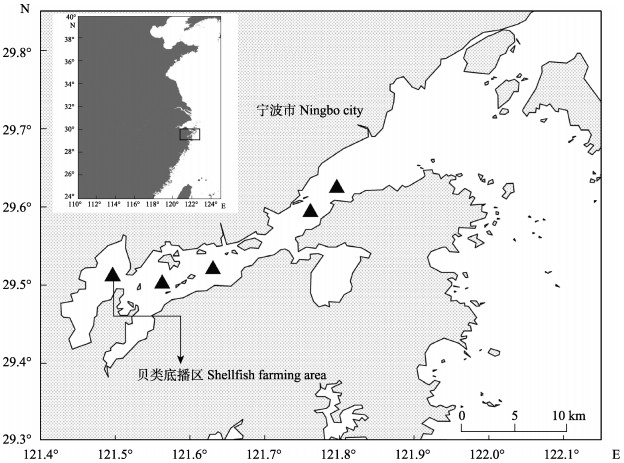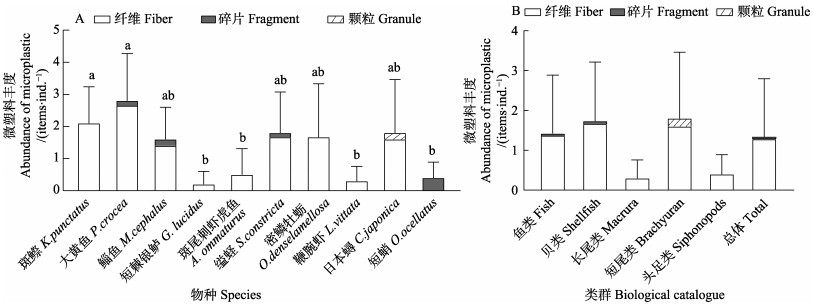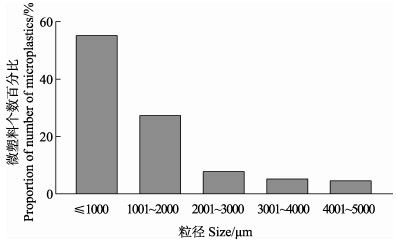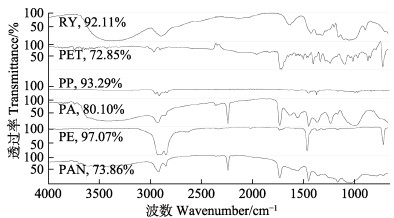2. 自然资源部第二海洋研究所 海洋生态系统动力学重点实验室 浙江 杭州 310012;
3. 中国科学院大学 北京 100049
2. Key Laboratory of Marine Ecosystem Dynamics, Second Institute of Oceanography, Ministry of Natural Resources, Hangzhou, Zhejiang 310012, China;
3. University of Chinese Academy of Sciences, Beijing 100049, China
微塑料通常指粒径小于5 mm的塑料微粒,广泛存在于从近海到大洋、表层海水到沉积物的海洋环境中(Thompson et al, 2004; Moore, 2008; Bessa et al, 2018)。据报道,目前约有1.5×109~5.1×109个塑料颗粒漂浮在海洋表面,总重达2.4×105 t,其中,微塑料占比高达90%以上(Eriksen et al, 2014; van Sebille et al, 2015)。按形成途径可将微塑料分为初生微塑料和次生微塑料(夏斌等, 2019)。初生微塑料是指工业生产之初就被制成微米级的小塑料微粒,如工业磨料中添加的塑料微珠等;次生微塑料则指大型塑料碎片在环境中经物理、化学和生物过程分裂或降解而形成的塑料微粒(Cooper et al, 2010; 李道季, 2019)。这些塑料微粒可通过风、洋流和降水等过程进行远距离迁移,扩散到全球海洋的各个区域(Thiel et al, 2003)。
微塑料由于与一些海洋生物的饵料(如浮游生物)粒径大小相似,很容易通过被摄取进入生物体内,进而对海洋生物的生理活动产生影响(武芳竹等, 2019; Sun et al, 2019; Zhu et al, 2019)。进入生物体内的微塑料会直接损伤、堵塞消化道,造成生物的摄食效率降低、能量匮乏,生长迟缓等问题,也会通过其吸附的重金属和持久性有机污染物(POPs)加重对生物的毒性作用,甚至导致生物个体死亡(Derraik et al, 2002; 孙晓霞等, 2016; 刘强等, 2017; 夏斌等, 2019)。科学合理评估海洋生物体内微塑料的污染特征并了解其影响因素是正确认识微塑料生态风险的基础。研究发现,环境中微塑料的污染水平与海洋生物的生活方式、习性等会对海洋生物体内微塑料丰度产生影响。在珠江口,牡蛎体内微塑料丰度与其生活水环境中微塑料丰度显著正相关(Li et al, 2018);在矛尾海,底栖鱼类体内微塑料丰度显著高于中上层鱼类(Zhu et al, 2018)。此外,目前对鱼类摄入微塑料的研究大多集中于胃和肠道,但在鱼类鳃丝中同样发现了微塑料的留存(Jabeen et al, 2017; Huang et al, 2019)。
象山湾位于浙江省东部沿海,是众多渔业生物的产卵场、育幼场和重要的海水养殖区。受长期的渔业生产和其他人类活动影响,该水域的微塑料污染问题比较明显(付翔等, 2012; 刘永超等, 2016; Chen et al, 2018)。研究发现,微塑料在该水域的表层海水和表层沉积物中的平均丰度分别达到9个/m3和74个/kg,在我国近岸水域处于较高水平(Chen et al, 2018; Wu et al, 2019)。相对于海水和沉积物中微塑料的研究,目前对该海域海洋生物中微塑料的研究较少。本文研究了象山湾水域10种常见海洋生物体内微塑料的种类、数量、粒径和成分组成等问题,以期为科学认识该水域微塑料在海洋生物体内的分布状况和累积特征、评估海湾生态系统健康和水产品生态风险提供科学依据。
1 材料与方法 1.1 样品采集样品采集于2019年5月象山湾渔业资源与环境调查航次,用底拖网采集到8种生物,包括斑

|
图 1 生物样品采样站位 Fig.1 Sampling sites of the biological samples in Xiangshan Bay |
|
|
表 1 象山湾10种生物样本及其体内组织中检出的微塑料基本信息 Tab.1 Basic information of the biological speciemen (10 species) collected from Xiangshan Bay and the microplastics identified in the tissues |
生物样品在室温下解冻、洗净、沥干后进行生物学测量。鱼类和虾类测量体长与体重,头足类测量胴长与体重,蟹类测量头胸甲长、头胸甲宽与体重,贝类测量壳长、壳高、壳宽及带壳湿重。长度、体重分别精确到0.1 cm、0.1 g。
解剖生物样品,取出个体软组织(鱼类取鳃、肠胃和背部肌肉,虾类、贝类去壳后取全部软组织,蟹类取头胸部软组织,头足类取头部组织及消化道)进行消解。生物组织消解参照Bessa等(2018)方法,将样品置于500 mL烧杯中,加入200 mL 10% KOH溶液,用锡箔纸将烧杯密封,放置于60℃烘箱中48 h,直至生物组织消解完全。消解液经玻璃纤维膜(GF/F,孔径0.7 μm;直径47 mm)过滤,用去离子水冲洗过滤装置内壁3次,使样品全部转移到滤膜上。取下滤膜后,置于洁净的玻璃培养皿中,贴好标签并置于60℃烘箱中烘干。
1.3 微塑料镜检与化学成分鉴定在体式显微镜(SteREO Discovery V8 Zeiss, Carl Zeiss Microimaging GmbH, 德国)下鉴别、提取和计数样品中的微塑料个体并拍照(OPLENIC C33, 美国),测量微塑料个体的粒径(ZEN Lite, Carl Zeiss Microimaging GmbH, 德国)。参照Hidalgo-Ruz等(2012)的方法,将检测到的微塑料分为纤维、碎片和颗粒3种形状,其中,纤维状为细长的丝状,不包括较粗的渔网、渔绳等线状微塑料;碎片状为不规则的扁平状微塑料;颗粒状为不规则的小塑料颗粒。利用傅里叶变换显微红外光谱仪(μ-FTIR)(Nicolet iN10, Thermo Fisher Scientific, 美国)对镜检挑出的疑似微塑料个体进行化学成分分析。在(50×50) μm ~ (150×150) μm光圈、8 cm–1分辨率和液氮冷却透射模式下对微塑料个体扫描64次,在4000~ 650 cm–1光谱范围内进行测试分析和记录光谱。将所获取的光谱与有机聚合物谱库进行比对,验证聚合物类型(匹配度大于70%则认为是该类型)。
1.4 质量控制样品前处理和测试分析过程中均设置3组空白对照,以检验实验过程中的微塑料污染状况。经检测,空白对照组中均未发现微塑料留存。PE标准品(国家海洋环境监测中心)回收率实验结果显示回收率为95.3%。为保证结果的准确性,在整个取样和分析过程中均采取了防污染措施。例如,实验前所有实验用品均用过滤后的去离子水润洗3次,实验过程中所有溶液在使用前均经玻璃纤维滤膜(GF/F,孔径0.7 μm;直径47 mm)过滤,所有开口容器均用锡箔纸覆盖,实验器皿均为非塑料物品等。样品测试分析时,对体式显微镜、傅里叶变换显微红外光谱仪等实验仪器定期校准以保证设备的准确性。
1.5 数据分析数据用平均值±标准差(Mean±SD)表示。利用Kruskal-Wallis方法检验不同生物物种或类群摄入的微塑料的丰度间差异(R 3.5.3软件),对存在显著差异的组间进行多重比较检验(Dunn test),差异显著性水平为P < 0.05。
2 结果 2.1 生物组织内微塑料的丰度所有物种体内均有微塑料出现,但不同物种间的微塑料丰度和检出率存在差异(表 1和图 2)。就生物组织而言,在鱼类消化道中检测出了微塑料,但在肌肉中未发现微塑料留存。在所有生物样本中共检出131个微塑料,生物个体内微塑料的平均丰度为(1.3±1.5)个。生物个体内微塑料的平均丰度在物种间存在显著差异(Kruskal-Wallis检验,P < 0.05),大黄鱼[(2.8±1.5)个]和斑

|
图 2 不同物种(A)和类群(B)的生物体内微塑料平均丰度 Fig.2 The individual mean abundance of microplastics identified in the tissues of the samples in terms of species (A) and biological catalogue (B) 不同字母代表物种间差异显著,Kruskal-Wallis检验,Dunn test, P < 0.05 Different letters represent significant difference among species, Kruskal-Wallis test, Dunn test, P < 0.05 |
就生物类群而言,生物个体内微塑料的平均丰度在(0.3±0.5)个(长尾类)至(1.8±1.7)个(短尾类)之间,但生物类群间的差异不显著(Kruskal-Wallis检验, P > 0.05)。
2.2 微塑料的形状类型、粒径分布和成分组成总体上,生物体内检出的微塑料有3种形状:纤维状(95.4%)、碎片状(3.1%)和颗粒状(1.5%)。纤维状微塑料在所有物种的体内均有出现,碎片状微塑料出现在鲻鱼(12.5%)、缢蛏(7.4%)和大黄鱼(5.6%)体内,颗粒状微塑料仅出现在日本蟳体内(11.1%)(图 2A)。就类群而言,碎片状微塑料出现在贝类(3.8%)和鱼类(3.7%)个体内,颗粒状微塑料仅出现在短尾类个体内(11.1%)(图 2B)。
微塑料粒径范围为110~4, 796 μm,平均粒径为(1, 246±1, 119) μm,其中,≤1, 000 μm的微塑料占比最高(55.2%),1, 001~2, 000 μm的微塑料次之(27.3%),2, 001~5, 000 μm的微塑料占比17.5%(图 3)。

|
图 3 生物体内微塑料的粒径分布 Fig.3 The percentage distribution of the size of microplastics identified in the tissues of the samples |
以化学成分组成划分,生物体内检出的微塑料有9种类型,包括人造丝(rayon, RY; 74.0%)、聚对苯二甲酸乙二醇酯(polyethylene terephthalate, PET; 14.5%)、聚丙烯(polypropylene, PP; 3.8%)、聚酰胺(polyamide, PA; 3.1%)、聚乙烯(polyethylene, PE; 1.5%)、聚碳酸酯(polycarbonate, PC; 0.8%)、聚丙烯腈(polyacrylnitrile, PAN; 0.8%)、聚乙烯醇(polyvinyl alcohol, PVA; 0.8%)和乙烯–醋酸乙烯共聚物(ethylene/vinyl acetate, EVA; 0.8%; 图 4)。

|
图 4 不同物种(A)和类群(B)的生物个体内微塑料的化学成分类型组成 Fig.4 The percentage distribution of the chemical type of microplastics identified in the tissues of the samples in terms of species (A) and biological catalogue (B) |

|
图 5 生物体内5种主要微塑料的红外光谱 Fig.5 The μ-FTIR spectra of five main microplastics identified in the tissues of the samples 图中的百分比数字为获取的光谱与有机聚合物谱库比对后的匹配度 The percentage indicates the matching degree of a spectrum obtained with the organic polymer library |
就物种而言,RY占比最高(40.0%~100.0%,平均74.0%),出现在所有物种体内;PET(4.8%~50.0%)出现在除日本蟳外所有物种体内;PP出现在缢蛏(7.4%)和斑

研究发现,在海洋中的藻类、浮游动物、双壳类、鱼类和海洋哺乳动物等众多种生物的体内均检出微塑料(Woods et al, 2018)。象山湾常见的贝类、短尾类、长尾类、头足类和鱼类的体内均出现不同丰度水平的微塑料,表明在该水域的海洋生物体内存在微塑料污染的现象具有一定普遍性。海洋生物体内微塑料丰度与水环境(水体、沉积物等)中微塑料的污染水平相关,前者可间接反映后者的污染水平(Pellini et al, 2018)。例如,通常情况下,相对于大洋和深海生物,栖息在受人类活动影响剧烈的近海和海湾水域的生物摄入塑料碎片或微塑料的现象更明显(Moore et al, 2001; Jabeen et al, 2017)。
象山湾10种生物体内微塑料的个体平均丰度为(1.3±1.5)个,与土耳其近海[1.8个,大西洋鲷(Sparus aurata)等28种鱼类](Güven et al, 2017)和英吉利海峡[1.9个,海鲂(Zeus faber)等10种鱼类](Lusher et al, 2013)生物体内的微塑料水平相当。这一丰度值高于黄海[0.4个,小黄鱼(Larimichthys polyactis)等19种鱼类](Sun et al, 2019)及葡萄牙近岸水域[0.3个,白姑鱼(Argyrosomus regius)等26种鱼类](Neves et al, 2015)生物体内微塑料的水平,但低于东京湾[2.3个,日本鳀(Engraulis japonicus)](Tanaka et al, 2016)、舟山嵊泗马鞍列岛[2.3~7.3个,海鳗(Muraenesox cinereus)等9种鱼类](Zhang et al, 2019)、湛江红树林湿地[2.8个,赤点石斑鱼(Epinephelus akaara)等32种鱼类](Huang et al, 2019)、南海[胃2.0个,肠1.8个,日本尖牙鲈(Synagrops japonicus)等13种鱼类](Zhu et al, 2019)、波斯湾[3.7~17.7个,拟蟹守螺(Cerithidea cingulata)等5种软体动物](Naji et al, 2018)和海州湾[13.5~22.2个,赤鼻棱鳀(Thryssa kammalensis)等6种鱼类] (Feng et al, 2019)生物体内微塑料的水平。海洋环境中微塑料污染水平的不同会导致各研究水域的生物体内微塑料丰度产生差异(Abidli et al, 2019)。例如,在海州湾,生活于河口区的赤鼻棱鳀体内的微塑料丰度明显高于其他水域的个体内的微塑料水平(Feng et al, 2019);在黄海南部,底栖生物体内的微塑料丰度与表层沉积物中微塑料丰度显著正相关(Wang et al, 2018)。
海洋生物的生活习性也会影响其体内微塑料的丰度水平。深海表层沉积物是海洋塑料最终聚集的汇,即使低密度的微塑料也会通过各种生物过程沉降到海底,从而增加底栖生物摄入微塑料的风险(Zhang et al, 2019)。已有研究表明,部分底栖生物体内的微塑料丰度要高于中上层生物体内的微塑料丰度(Jabeen et al, 2017),如生活在泥沙中的贝类体内通常表现出较高水平的微塑料丰度(Abidli et al, 2019)。而生物摄食策略是影响其体内微塑料丰度的另一个重要因素(Jabeen et al, 2017)。一般而言,在同一水环境中,相对于主要从环境中直接摄入微塑料的小型滤食性生物(如中上层小型鱼类、小型虾和贝类),大型捕食者除了通过呼吸、滤水等活动从环境中直接摄取微塑料外,还可以通过大量捕食含有微塑料的饵料生物而摄取更多的微塑料,导致其体内个体微塑料丰度水平升高(Zhang et al, 2019)。但捕食者对饵料的选择性及微塑料在生物体内滞留时间的差异会导致不同高营养级捕食者体内微塑料丰度的差异(Güven et al, 2017; Abidli et al, 2019)。在本研究中,不同类群生物体内微塑料的个体丰度未出现显著的统计学差异,生物体内微塑料丰度水平的种间差异与其摄食习性的相关性也不明显。部分其他海域的生物体内微塑料丰度水平也显示出类似的结果(Chan et al, 2019)。此外,本研究中短棘银鲈和鞭腕虾等小个体生物体内微塑料丰度显著低于斑
研究方法的差异也会对生物体内微塑料丰度的检测结果造成影响。如本研究中鱼类的相关结果所示,由于鱼类首先通过呼吸和滤水直接从环境中摄入微塑料,作为其呼吸和滤水器官,鳃丝中一般也留存了一定比例的微塑料。有些研究只计测其消化道内的微塑料数量,会低估鱼类体内的微塑料丰度水平。此外,研究中生物组织的消解方法和消解程度的差异也会导致对生物体内微塑料丰度检测结果的偏差(王昆等, 2017)。例如,浓酸消解法会对PA等微塑料造成损伤,甚至在提取过程中这种类型的塑料被完全破坏,导致其检测丰度被低估(Claessens et al, 2013)。本研究利用对微塑料损伤较轻、消解效果较好的强碱消解法对鱼类多组织内的微塑料进行了检测,改善了生物体内微塑料的检测效率。
3.2 生物体内微塑料组成特征本研究中,象山湾10种常见生物体内检测出了纤维状、碎片状和颗粒状3种形状类型的微塑料,以纤维状个体占绝对优势(95.4%),与该海域沉积物中其占比较高(94.7%)相对应(Wu et al, 2019)。纤维是海洋环境和生物体中常见的微塑料形状,本研究的结果与国内外其他水域的相关研究结果相吻合(Lusher et al, 2013; Feng et al, 2019)。例如,在海州湾、香港、嵊泗马鞍列岛、葡萄牙和西班牙附近海域,鱼类摄入纤维状微塑料个体分别占比98.0%、84.0%、83.5%、65.8%和71.0% (Neves et al, 2015; Bellas et al, 2016; Chan et al, 2019; Feng et al, 2019; Zhang et al, 2019)。海洋环境中较高的纤维状微塑料丰度及其物理特征会使其更易被海洋生物摄入和累积。例如,黄海鱼类消化道内纤维状塑料占消化道检出微塑料总量的67.0%,而沉积物中纤维状微塑料比例为93.9%(Zhao et al, 2018; Sun et al, 2019);舟山嵊泗马鞍列岛附近海域的鱼类消化道内纤维状塑料占检出微塑料总数量的83.5%,而水体和沉积物中纤维状微塑料分别占比70.0%和92.0% (Zhang et al, 2019)。另外,纤维状微塑料更容易缠绕在生物的鳃上且进入消化道后不易被排出,导致生物体内纤维状微塑料的累积。例如,微塑料可通过岸蟹(Carcinus maenas)的呼吸过程进入鳃室,并在鳃室内积累(Watts et al, 2014);在挪威海螯虾(Nephrops norvegicus)中,纤维状微塑料易滞留和累积在前肠而不能被完全排空,导致消化道内的微塑料丰度升高(Murray et al, 2011)。
海洋环境和生物体内已被检出的微塑料成分有10多种,主要以RY、PE、PP、PS和PET等5种塑料为主。在象山湾10种常见生物体内检测出了9种微塑料,以RY(74.0%)和PET(14.5%)为主,PP(3.8%)和PA(3.1%)次之,其他包括PE、PC、PAN、PVA和EVA等(4.7%),这与该水域环境中表层沉积物微塑料的成分组成情况大致吻合(RY, 60.0%~88.0%; PP, 8.0%~28.0%)(Wu et al, 2019)。类似结果在其他研究中也有报道(Neves et al, 2015)。如英吉利海峡附近海域10种鱼类体内检出的微塑料成分以RY(57.8%)为主,PA(35.6%)和PE(5.1%)等次之(Lusher et al, 2013); 孟加拉湾北部2种虾类体内被检出的微塑料成分为PA(68.4%)和RY(31.6%)(Hossain et al, 2019)。这几种主要类型聚合物均为日常生活中和海洋环境中常见的塑料化合物。RY通常被用作个人卫生及纺织用品,而一次日常衣物清洗可产生多达1900个塑料纤维(Browne et al, 2011),这些塑料纤维可随污水处理后的废水进入海洋。而PE、PP和PET在日常生活中也被广泛生产和使用。例如,近年来,欧洲的PE、PP和PET年产量占总塑料产量的50%以上(Plastics Europe, 2019)。大量的微塑料在生产和使用过程中通过各种方式进入海洋并被广泛运输和扩散,成为主要的全球性海洋微塑料污染源和留存于生物体内的微塑料主体。
就全球海洋微塑料分布而言,微塑料整体呈现出随粒径增大而丰度减小的趋势(Wang et al, 2018; Mu et al, 2019; Wu et al, 2019)。例如,在局部海域,南海表层海水小型微塑料(0.02~0.3 mm)是中大型微塑料(0.3~5 mm)丰度的100倍以上(Cai et al, 2018);在黄海南部沉积物中,< 1 mm的微塑料占比高达81.0% (Wang et al, 2018)。相应地,海洋生物体内出现的小粒径微塑料的丰度普遍高于较大粒径微塑料的丰度。在黄海南部沉积物中,0~1 mm、1~2 mm和2~5 mm粒径的微塑料分别占比81%、12%和7%,生活于该海域的底层鱼类体内,3种粒径的塑料则分别占比61.4%、20.4%和18.2%(Wang et al, 2018);在舟山嵊泗马鞍列岛表层海水和沉积物中,< 1 mm的微塑料分别占比78.3%和86.5%,生活于该水域的鱼类体内,< 1 mm的微塑料占比77.3%,与表层海水和沉积物粒径分布趋势一致(Zhang et al, 2019)。象山湾10种常见生物体内出现的微塑料个体粒径为0.11~4.80 mm,以≤0.5 mm (30.0%)和0.5~1.0 mm (25.2%)的小型微塑料居多,与该水域环境中的微塑料以小型微塑料为主一致(Chen et al, 2018)。而且,较大粒径的微塑料通常出现在大黄鱼等较大的生物个体体内。一方面,生物内微塑料的粒径组成可能与环境中微塑料粒径组成有关(Lima et al, 2014);另一方面,生物个体大小和摄食习性也会影响其摄取的微塑料的粒径组成(Boerger et al, 2010)。小型浮游动物一般通过滤食主要摄取水体中一些小型微塑料,而大型捕食者(如鱼类和头足类)则更容易通过滤水和吞食等方式从环境或食物中摄入更大粒径的微塑料,导致不同类群或个体大小的生物间摄取的微塑料粒径组成产生差异。
3.3 养殖设施对象山湾生物体内微塑料的影响本研究在生物体内未发现渔网、渔绳等线状和养殖浮标等产生的典型的泡沫状微塑料。成分分析也显示,PE、PP和PS等养殖设施常用的塑料类型也较少。在贝类和藻类重要养殖区海州湾的6种底层鱼类体内也发现了类似的微塑料分布特征(Feng et al, 2014; 李征等, 2020),即鱼类体内的微塑料可能与养殖设施产生的微塑料关系较小。渔网和渔绳等产生的线状微塑料通常粒径较大,鱼类相对不易误食这类微塑料,养殖浮标等产生的泡沫状微塑料密度较低,容易悬浮在上层水体。在象山湾底部沉积物中也同样未发现泡沫状和PS类型的微塑料(Wu et al, 2019)。本研究以底层物种为主,因此,养殖设施对其摄食微塑料的影响可能较小。
4 结论本研究通过对象山湾10种海洋生物体内的微塑料污染特征调查发现,微塑料在生物体内普遍存在,形状类型和成分组成分别以纤维状和人造丝为主,以小粒径微塑料个体居多,丰度较其他研究海域处于中等水平,养殖设施对本研究的10种生物体内微塑料影响较小。在鱼类鳃丝和肠胃中均检测出微塑料颗粒,而在肌肉中未发现微塑料污染,表明微塑料会通过鱼类呼吸过程进入鳃中,通过摄食过程进入消化器官,从而可能对鱼类呼吸与消化产生影响。海洋环境中微塑料的污染水平与海洋生物的生活方式、生活习性均会对微塑料在海洋生物体内的丰度、形状类型、粒径分布和成分组成等产生影响。为科学评估微塑料对生物的影响风险,未来还应加强研究生物对微塑料的摄食效率、微塑料在生物体内各组织器官内的分布特征、滞留时间及污染物释放率等科学问题。
ABIDLI S, LAHBIB Y, EL MENIF N T. Microplastics in commercial molluscs from the lagoon of Bizerte (Northern Tunisia). Marine Pollution Bulletin, 2019, 142: 243-252 DOI:10.1016/j.marpolbul.2019.03.048 |
BELLAS J, MARTíNEZ-ARMENTAL J, MARTíNEZ- CáMARA A, et al. Ingestion of microplastics by demersal fish from the Spanish Atlantic and Mediterranean coasts. Marine Pollution Bulletin, 2016, 109(1): 55-60 DOI:10.1016/j.marpolbul.2016.06.026 |
BESSA F, BARRíA P, NETO J M, et al. Occurrence of microplastics in commercial fish from a natural estuarine environment. Marine Pollution Bulletin, 2018, 128: 575-584 DOI:10.1016/j.marpolbul.2018.01.044 |
BOERGER C M, LATTIN G L, MOORE S L, et al. Plastic ingestion by planktivorous fishes in the North Pacific Central Gyre. Marine Pollution Bulletin, 2010, 60(12): 2275-2278 DOI:10.1016/j.marpolbul.2010.08.007 |
BROWNE M A, CRUMP P, NIVEN S J, et al. Accumulation of microplastic on shorelines worldwide: Sources and sinks. Environmental Science and Technology, 2011, 45(21): 9175-9179 DOI:10.1021/es201811s |
CAI M, HE H, LIU M, et al. Lost but can't be neglected: Huge quantities of small microplastics hide in the South China Sea. Science of the Total Environment, 2018, 633: 1206-1216 DOI:10.1016/j.scitotenv.2018.03.197 |
CHAN H S H, DINGLE C, NOT C. Evidence for non-selective ingestion of microplastic in demersal fish. Marine Pollution Bulletin, 2019, 149: 110523 DOI:10.1016/j.marpolbul.2019.110523 |
CHEN M, JIN M, TAO P, et al. Assessment of microplastics derived from mariculture in Xiangshan Bay, China. Environmental Pollution, 2018, 242: 1146-1156 DOI:10.1016/j.envpol.2018.07.133 |
CLAESSENS M, VAN CAUWENBERGHE L, VANDEGEHUCHTE M B, et al. New techniques for the detection of microplastics in sediments and filed collcted organisms. Marine Pollution Bulletin, 2013, 70(1/2): 227-233 |
COOPER D A, CORCORAN P L, PATRICIA L C. Effects of mechanical and chemical processes on the degradation of plastic beach debris on the island of Kauai, Hawaii. Marine Pollution Bulletin, 2010, 60(5): 650-654 |
DERRAIK J G. The pollution of the marine environment by plastic debris: A review. Marine Pollution Bulletin, 2002, 44(9): 842-852 DOI:10.1016/S0025-326X(02)00220-5 |
ERIKSEN M, LEBRETON L C, CARSON H S, et al. Plastic pollution in the world's oceans: More than 5 trillion plastic pieces weighing over 250, 000 tons afloat at sea. PLoS One, 2014, 9(12): e111913 DOI:10.1371/journal.pone.0111913 |
FENG Z, ZHANG T, LI Y, et al. The accumulation of microplastics in fish from an important fish farm and mariculture area, Haizhou Bay, China. Science of the Total Environment, 2019, 696: 133948 DOI:10.1016/j.scitotenv.2019.133948 |
FU X, HAO Q, LIU CG, et al. Simulation for polyculture and eutrophication in Xiangshan Harbor. Progress in Fishery Sciences, 2012, 33(1): 1-9 [付翔, 郝锵, 刘诚刚, 等. 象山港多品种养殖与富营养化状况的数值模拟. 渔业科学进展, 2012, 33(1): 1-9 DOI:10.3969/j.issn.1000-7075.2012.01.001] |
GÜVEN O, GÖKDAĞ K, JOVANOVIĆ B, et al. Microplastic litter composition of the Turkish territorial waters of the Mediterranean Sea, and its occurrence in the gastrointestinal tract of fish. Environmental Pollution, 2017, 223: 286-294 DOI:10.1016/j.envpol.2017.01.025 |
HIDALGO-RUZ V, GUTOW L, THOMPSON R C, et al. Microplastics in the marine environment: A review of the methods used for identification and quantification. Environmental Science and Technology, 2012, 46(6): 3060-3075 DOI:10.1021/es2031505 |
HOSSAIN M S, RAHMAN M S, UDDIN M N, et al. Microplastic contamination in Penaeid shrimp from the Northern Bay of Bengal. Chemosphere, 2019, 238: 124688 |
HUANG J S, BIMALI KOONGOLLA J, LI H X, et al. Microplastic accumulation in fish from Zhanjiang mangrove wetland, South China. Science of the Total Environment, 2019, 708: 134839 |
JABEEN K, SU L, LI J, et al. Microplastics and mesoplastics in fish from coastal and fresh waters of China. Environmental Pollution, 2017, 221: 141-149 DOI:10.1016/j.envpol.2016.11.055 |
LI DX. Research advance and countermeasures on marine microplastic pollution. Research of Environmental Sciences, 2019, 32(2): 197-202 [李道季. 海洋微塑料污染状况及其应对措施建. 环境科学研究, 2019, 32(2): 197-202] |
LI Z, GAO C M, YANG J L, et al. Distribution characteristics of microplastics in surface water and sediments of Haizhou Bay, Lianyungang. Environmental Science, 2020, 41(7): 3212-3221 [李征, 高春梅, 杨金龙, 等. 连云港海州湾海域表层水体和沉积物中微塑料的分布特征. 环境科学, 2020, 41(7): 3212-3221] |
LI H X, MA L S, LIN L, et al. Microplastics in oysters Saccostrea cucullata along the Pearl River estuary, China. Environmental Pollution, 2018, 236: 619-625 DOI:10.1016/j.envpol.2018.01.083 |
LIMA A R A, COSTA M F, BARLETTA M, et al. Distribution patterns of microplastics within the plankton of a tropical estuary. Environmental Research, 2014, 132: 146-155 DOI:10.1016/j.envres.2014.03.031 |
LIU Q, XU X D, HUANG W, et al. Research advances on the ecological effects of microplastic pollution in the marine environment. Acta Ecologica Sinica, 2017, 37(22): 7397-7409 [刘强, 徐旭丹, 黄伟, 等. 海洋微塑料污染的生态效应研究进展. 生态学报, 2017, 37(22): 7397-7409] |
LIU Y C, LI J L, YUAN Q X, et al. Coastline and landscape changes in bay areas caused by human activities: A comparative analysis of Xiangshan Bay, China and Tampa Bay, USA. Journal of Geographical Sciences, 2016, 71(1): 86-103 [刘永超, 李加林, 袁麒翔, 等. 人类活动对港湾岸线及景观变迁影响的比较研究: 以中国象山湾与美国坦帕湾为例. 地理学报, 2016, 71(1): 86-103] |
LUSHER A L, MCHUGH M, THOMPSON R C. Occurrence of microplastics in the gastrointestinal tract of pelagic and demersal fish from the English Channel. Marine Pollution Bulletin, 2013, 67(1/2): 94-99 |
MOORE C J, MOORE S L, LEECASTER M K, et al. A comparison of plastic and plankton in the North Pacific Central Gyre. Marine Pollution Bulletin, 2001, 42(12): 1297-1300 DOI:10.1016/S0025-326X(01)00114-X |
MOORE C J. Synthetic polymers in the marine environment: A rapidly increasing, long-term threat. Environmental Research, 2008, 108(2): 131-139 DOI:10.1016/j.envres.2008.07.025 |
MU J, ZHANG S, QU L, et al. Microplastics abundance and characteristics in surface waters from the Northwest Pacific, the Bering Sea, and the Chukchi Sea. Marine Pollution Bulletin, 2019, 143: 58-65 DOI:10.1016/j.marpolbul.2019.04.023 |
MURRAY F, COWIE P R. Plastic contamination in the decapod crustacean Nephrops norvegicus (Linnaeus, 1758). Marine Pollution Bulletin, 2011, 62(6): 1207-1217 DOI:10.1016/j.marpolbul.2011.03.032 |
NAJI A, NURI M, VETHAAK A D. Microplastics contamination in molluscs from the northern part of the Persian Gulf. Environmental Pollution, 2018, 235: 113-120 DOI:10.1016/j.envpol.2017.12.046 |
NEVES D, SOBRAL P, FERREIRA J L, et al. Ingestion of microplastics by commercial fish off the Portuguese coast. Marine Pollution Bulletin, 2015, 101(1): 119-126 DOI:10.1016/j.marpolbul.2015.11.008 |
PELLINI G, GOMIERO A, FORTIBUONI T, et al. Characterization of microplastic litter in the gastrointestinal tract of Solea solea from the Adriatic Sea. Environmental Pollution, 2018, 234: 943-952 DOI:10.1016/j.envpol.2017.12.038 |
Plastics Europe. Plastics-the fact: An analysis of European plastics production. demand and waste data, 2019 |
SUN X X, LI Q J, SHI Y Q, et al. Characteristics and retention of microplastics in the digestive tracts of fish from the Yellow Sea. Environmental Pollution, 2019, 249: 878-885 DOI:10.1016/j.envpol.2019.01.110 |
SUN X X. Progress and prospect on the study of the ecological risk of microplastics in the ocean. Advances in Earth Science, 2016, 31(6): 560-566 [孙晓霞. 海洋微塑料生态风险研究进展与展望. 地球科学进展, 2016, 31(6): 560-566] |
TANAKA K, TAKADA H. Microplastic fragments and microbeads in digestive tracts of planktivorous fish from urban coastal waters. Scientific Reports, 2016, 6(1): 34351 DOI:10.1038/srep34351 |
THIEL M, HINOJOSA I, VáSQUEZ N, et al. Floating marine debris in coastal waters of the SE-Pacific (Chile). Marine Pollution Bulletin, 2003, 46(2): 224-231 DOI:10.1016/S0025-326X(02)00365-X |
THOMPSON R C, OLSEN Y, MITCHELL R P, et al. Lost at sea: Where is all the plastic?. Science, 2004, 304(5672): 838 DOI:10.1126/science.1094559 |
VAN SEBILLE E, WILCOX C, LEBRETON L, et al. A global inventory of small floating plastic debris. Environmental Research Letters, 2015, 10(12): 124006 DOI:10.1088/1748-9326/10/12/124006 |
WANG J, WANG M X, RU S G, et al. High levels of microplastic pollution in the sediments and benthic organisms of the South Yellow Sea, China. Science of the Total Environment, 2018, 651: 1661-1669 |
WANG K, LIN K D, YUAN D X. Research progress on the analysis of microplastics in the environment. Environmental Chemistry, 2017, 36(1): 27-36 [王昆, 林坤德, 袁东星. 环境样品中微塑料的分析方法研究进展. 环境化学, 2017, 36(1): 27-36] |
WATTS A J R, LEWIS C, GOODHEAD R M, et al. Uptake and retention of microplastics by the shore crab Carcinus maenas. Environmental Science and Technology, 2014, 48(15): 8823-8830 DOI:10.1021/es501090e |
WOODS M N, STACK M E, FIELDS D M, et al. Microplastic fiber uptake, ingestion, and egestion rates in the blue mussel (Mytilus edulis). Marine Pollution Bulletin, 2018, 137: 638-645 DOI:10.1016/j.marpolbul.2018.10.061 |
WU F Z, WANG Y J, LEUNG J Y S, et al. Accumulation of microplastics in typical commercial aquatic species: A case study at a productive aquaculture site in China. Science of the Total Environment, 2019, 708: 135432 |
WU F Z, ZENG J N, XU X Q, et al. Status of marine microplastic pollution and its ecotoxicological effects on marine fish. Haiyang Xuebao, 2019, 41(2): 85-98 [武芳竹, 曾江宁, 徐晓群, 等. 海洋微塑料污染现状及其对鱼类的生态毒理效应. 海洋学报, 2019, 41(2): 85-98 DOI:10.3969/j.issn.0253-4193.2019.02.008] |
XIA B, DU Y S, ZHAO X G, et al. Research progress on microplastics pollution in marine fishery water and their biological effects. Progress in Fishery Sciences, 2019, 40(3): 178-190 [夏斌, 杜雨珊, 赵信国, 等. 微塑料在海洋渔业水域中的污染现状及其生物效应研究进展. 渔业科学进展, 2019, 40(3): 178-190] |
ZHANG D, CUI Y, ZHOU H, et al. Microplastic pollution in water, sediment, and fish from artificial reefs around the Ma'an Archipelago, Shengsi, China. Science of the Total Environment, 2019, 703: 134768 |
ZHAO J, RAN W, TENG J, et al. Microplastic pollution in sediments from the Bohai Sea and the Yellow Sea, China. Science of the Total Environment, 2018, 640-641: 637-645 DOI:10.1016/j.scitotenv.2018.05.346 |
ZHU J, ZHANG Q, LI Y, et al. Microplastic pollution in the Maowei Sea, a typical mariculture bay of China. Science of the Total Environment, 2018, 658: 62-68 |
ZHU L, WANG H, CHEN B, et al. Microplastic ingestion in deep-sea fish from the South China Sea. Science of the Total Environment, 2019, 677: 493-501 DOI:10.1016/j.scitotenv.2019.04.380 |



